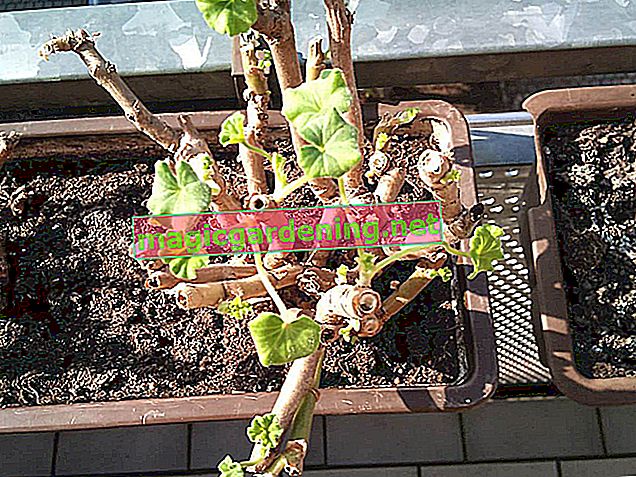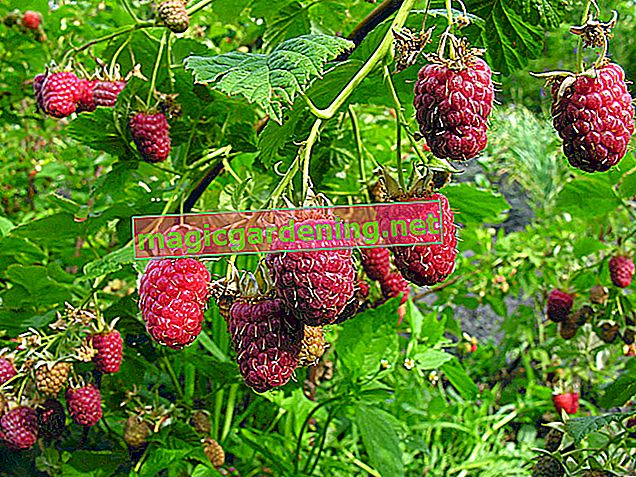
Types of cuts and dates
At this point, the all-clear can be given to concerned beginners in pruning the olive tree. The evergreen icon from the Mediterranean Sea is extremely easy to cut . You cannot cause serious damage with scissors or a saw, because the olive will sprout cheerfully even from old wood. Thanks to this property, various options open up to skilfully cut an olive tree as a jewel or a high-yield fruit tree. The following overview summarizes useful cutting types and recommended times:
also read
- Olive tree tolerates hot, but not frosty temperatures
- Pruning cherry tree productively - tutorial with all instructions
- How to overwinter your olive tree without damage
| Cut type | Goal / occasion | best date |
|---|---|---|
| Shape and maintenance cut container plant | Form and maintain a harmonious, densely leafed crown | Spring, just before wintering |
| Care cut | Correct late frost damage | End of June (Midsummer Day) |
| Upbringing | Building a high-yielding crown | 1st to 8th year of standing (first flowering period) |
| Fruit woodcut | Promote young fruitwood, preserve the crown | every 2 years in February |
| Taper cut | revitalize old olive tree | January to the end of February |
Cut the olive in the bucket
As a container plant, an olive tree creates an atmospheric color in the garden, on the balcony and terrace. In the front garden on the south side, the wood presents itself as a picturesque reception committee for the guests of the house. Anyone who is in the center of interest should always present a well-groomed appearance. A rich olive harvest takes a back seat. The following instructions explain how to properly cut an olive tree in a bucket:
- The best time is in spring, just before clearing out
- Remove all damaged, diseased or dried-up twigs in the winter quarters
- Ideally, prune to short stubs with two to three buds
- Do the same with unfavorably growing branches that point in the wrong direction
As the illustration below illustrates, always cut the side shoots on the crown or shrubbery back to short cones . Within a few weeks, remarkable young shoots sprout from these stumps. Without a cone cut, budding at this point takes much longer or is completely unnecessary if there are no sleeping eyes. It is thanks to this ingenious pruning technique that even extremely pruning subtropical trees, such as rhododendrons or azaleas, grow again after a pruning.

background
Sleeping eyes - the floral secret weapon against cut errors
The pruning tolerance of olive trees is primarily based on a whole host of sleeping eyes. In gardeners' language, this is the name given to the dormant bud systems that are located along the branches. As it grows, the Mediterranean wood creates the tiny vegetation points under the bark. Their only function is to replace parts of plants that fail as a result of an accident, storm and frost damage or pruning. In addition, sleepy eyes are activated if the gardener makes a mistake. Thanks to the floral “iron reserve”, holes in the bush or crown can be closed in no time at all.Correct late frost damage at the end of June - maintenance cut instructions
One time not paying attention, the olive cleared out too early and Godfather Frost has struck. Olive trees in pots are often victims of late frost. In the worst case, planted specimens are also affected. Classic symptoms are drooping leaves and shoot tips. In order to be able to assess the extent of the damage correctly, wait until the end of June before making a corrective maintenance cut. Close to St. John's Day (June 24th) cut a frozen olive tree like this:
- Perform summer maintenance pruning when the sky is overcast or in the shade
- Cut back frozen, limp shoots into healthy wood
- Ideally, blend on a healthy, further inward positioned side shoot
- Alternatively, shorten to a 2 cm short tenon
At first glance, it is usually not possible to tell where frozen wood ends on an olive branch and the healthy area begins. In this case, a simple vitality test will help. Late frosts primarily damage the cambium, which is located just below the bark. The bark itself is often not affected. Remove a little bark with a knife or fingernail. If a dark brown to black layer emerges, you are in the frozen wood. Gradually work your way towards the trunk. Scratch off fresh cream-colored to green tissue and you have reached the healthy wood.
Tips
Frost cracks on the native bark of olive trees are often associated with typical late frost damage. You can effectively prevent the fatal “labello effect” if you cover the trunk of planted olives with reed mats or simply lean against wooden slats. It is important to cushion the combination of dry cold and intense spring sun. Put tub olives in partial shade or cover the branches with breathable fleece. Please do not forget to water regularly.
Raising a productive crown
A plate crown or a hollow crown promise an optimal fruit yield on the olive tree. Many heat-loving fruit trees from distant countries benefit from these sun-drenched crown shapes, such as olive or peach trees. The scaffolding is formed by five evenly arranged scaffolding shoots, the top buds of which are in juice balance, i.e. are at the same level. In the case of a hollow crown, the central drive is removed. In the crown of the plate, all scaffold branches are of equal rank, without a dominant central shoot as a trunk extension. How to raise an olive tree with a high-yielding crown:
- The best time is in February until the start of the yield phase
- Plate crown: select a total of 5 equally strong leading branches on the trunk at a height of 100 to 150 cm
- Important: The starting points of the guide branches are at different trunk heights
- Extend the leading branches by 10 cm annually
- Cut back the previous year's growth to 10 cm
- Apply scissors just above an outward-facing bud
- Hollow crown: similar to the plate crown, but remove the dominant central shoot in the third year
By raising the main branches in stages to the desired final length, you encourage lush branching with side shoots. Each upbringing cut creates a local increase in sap pressure, whereupon dormant buds are activated and sprout. At the beginning of the harvest phase, it is the annual side branches that give you the flowers and olives you long for. The more stable a supporting scaffold shoot, the stronger the annual shoot of fruitwood may be.
Branches pointing vertically upwards are disadvantageous for any fruit tree. Already in the education phase, make sure that the leading branches are at an angle between 45 ° and 90 ° to the trunk . If the growth is too steep, it can be easily regulated with wooden spreader bars or a clothes peg. If a promising shoot hangs too low, tie it up with sisal at an ideal angle of 60 °. Consistently remove any tightly upright shoots that sprout from the scaffold shoots.
Digression
Correct cutting tool - key to success in pruning olive trees
If the perfect cutting unit is at hand, you will master the cut on the olive tree with flying colors. If the pruning care is dedicated to thin shoots up to 2 cm in diameter, a branded secateurs guarantees the best results. Cut branches with a diameter of up to 4 cm with pruning shears. In both cases, we recommend bypass scissors with 2 sharp blades. For the challenges of cutting thick branches on the old, mighty olive tree, you are perfectly equipped with a handy Japanese saw. You need a cleaning agent for blades and saw blades as well as a whetstone as accessories. Always cut your olive tree with sparkling clean cutting tools so that diseases and pests are not inadvertently transmitted.Promote and maintain fruit wood
A fully cultivated olive tree is subjected to fruit wood pruning at 2-year intervals. The slow growth with an average of 10 to 20 centimeters per year makes annual pruning unnecessary. The most important goal is the promotion of young fruit wood. Furthermore, a cut back ensures order in the crown so that the sunlight can penetrate into all regions. How to complete an impeccable fruit wood cut on the olive tree:
- The best time is between the beginning of February and the beginning of March on a frost-free, overcast day
- Cut back harvested shoots to short cones
- If possible, do not prune shoots from the previous year, because this is where the fruits thrive
- If necessary, shorten excessively long shoots from the previous year by a maximum of a third to an outward-facing bud
- Thinning out dead, weak shoots that are growing inside the crown
On the leading branches of the crown, cut the growth by a third or half since the last cut. The resulting juice jam causes fresh side shoots to sprout, which will bear fruit in the next year. If scaffold shoots or side branches hang over in an arch, look out for a side shoot or a bud that is located behind the base of the arch and sits on the top of the branch. This is where the cut is made.
Lead cut prevents unsightly gaps
Simply pruning oversized olive branches somewhere can leave unsightly gaps in their appearance. However, if you are familiar with the cutting technique of a lead, you can effectively prevent the aesthetic disruptive factor. This is how it works:
- Choose a side shoot on the top that faces outwards near the desired intersection
- Place scissors at the fork of the old and new shoot
- The ideal intersection point is 2 to 5 millimeters in the old wood
With the diversion cut, you redirect the flow of sap into a previously subordinate branch. This takes over the leadership position from now on, without the removal of the old, overlong shoot creating a gap.
Rejuvenate old olive tree
If the pruning of the olive tree is neglected for several years, the wood first loses its fertility. There can also be no question of a decorative crown. Instead, the former piece of jewelery has been transformed into an impenetrable network of old and young twigs that overshadow each other and bare. The good cut tolerance of olives allows a radical rejuvenation cut. How to proceed correctly step by step:
- The best time is in late winter, between the beginning of February and the beginning of March
- Check the crown carefully for feathered or fur-bearing winter guests in order to postpone the cut if necessary
- Use the saw to shorten all the leading branches to 50 to 80 centimeters above the base of the crown
- Apply nitrogen-stressed fertilizers to promote growth
The rejuvenation measure activates sleeping eyes, which will sprout vigorously over the next few years. A secondary crown is created on each guide branch . Each of these secondary crowns acts as the starting point for an individual structure as a plate or hollow crown with four to five equally ranked leading branches. Excess shoots are consistently removed.
Unless you value an olive harvest, raise the secondary crowns in a pyramidal shape. Choose a strong central shoot around which four main branches are evenly distributed. The tip of the central shoot should be about a scissor length above the tips of the leading branches. The tips of the leading branches grow evenly when their terminal buds are in the juice balance.
frequently asked Questions
My olive tree has been suffering from fungal attack since the beginning of summer. Can I cut the tree back a lot now in June so that it becomes lush again?
Olive trees generally tolerate heavy pruning. However, the time should not fall during the main vegetation season, which extends from April to September. The best date is between January and February, when the Mediterranean wood is at the end of its winter break.
Is an olive tree self-fertile?
An olive tree usually thrives with hermaphrodite flowers, so that it is self-fertile. Cross-pollination by a second copy increases the yield significantly. A few varieties are dependent on a genetically different pollinator. When purchasing a tree in a nursery or garden center, ask exactly if you are aiming for an olive harvest.
My olive tree is 3 years old and is in the bucket that I overwinter in the winter garden. This year the tree has lost a lot of leaves, so that some branches are completely bare. What are the causes? What can I do?
Leaf fall on the olive tree usually signals a lack of light or an unbalanced water balance. In winter quarters that are too dark, compensate for a lack of light with a plant lamp (€ 28.43 at Amazon *). Too much water causes the leaves to fall, as does drought stress. Container plants often suffer from waterlogging. In soil that is too moist, the roots can rot and mold. As a result, water and nutrients are no longer transported into the shoots and leaves. Pot the olive tree out and examine the condition of the substrate. You can remedy waterlogging by repotting the plant. In the event of drought stress, immerse the root ball in a bucket of soft water until no more air bubbles rise.
How much winter can an olive tree take?
The olive tree is at home around the Mediterranean, where temperatures can drop below freezing in winter. In general, the fruit trees can withstand temperatures of up to -10 degrees Celsius. In winter-mild regions of the winter hardiness zone Z8, such as the wine-growing areas or on the Lower Rhine, planted olive trees can be admired. But here, too, permanent winter wetness is a massive problem and requires extensive protective measures. In most cases, cultivation in the tub is advisable to protect the Mediterranean tree in the bright, cool winter quarters from severe frost.
I would like to replant my olive tree in a better location in the garden that has more sun and wind protection. When is the best time? What should I pay particular attention to?
An olive tree can still cope with transplanting within the first three to five years. Older specimens have already driven their dominant tap roots so deep into the ground that a change of location no longer makes sense. The best time is in spring when the soil is completely thawed. Cut out the root ball in a radius that roughly corresponds to the height of the trunk. Since a large amount of root mass is still lost, prune all shoots by a third or half before or after. The cut restores the balance between above-ground and underground plant components.
Olive tree is losing its leaves. Should I cut back the crown?
If individual leaves fall off, it is a natural process. Evergreen leaves are replaced by young leaves after a few years. The most common unnatural cause of leaf fall on the olive tree is lack of light. Mainly potted plants in winter quarters that are too dark are affected. Other triggers for the dilemma are waterlogging, drought stress and nutrient deficiencies. In all cases, a cut does not solve the problem. Plant lamps or a change of location ensure better lighting conditions. Repotting removes waterlogging, immersion in soft water regulates drought stress. Regular use of special fertilizers for olives helps against nutrient deficiencies.
I would like to plant an olive tree in the front yard. It must not be taller than 2 to 3 meters. There are no width restrictions. Can I limit the height of the olive tree by regular pruning?
Since there is enough space available in width, we recommend training with a plate crown. Construction and maintenance are associated with regular cutting work. In return, you limit the growth in height to match the space available. With four to five horizontal leading branches, the crown is not only beautiful to look at, but also gives you the first olive harvest in the sunny, warm location after six to eight years.
The 3 most common mistakes
If an olive tree is only vaguely reminiscent of the original piece of jewelery with Mediterranean charm, it is mostly due to incorrect pruning. The following table lists the three most common cutting errors in olives by name, provides information on typical damage patterns and offers tips for safe prevention:
| Cutting errors | Damage | prevention |
|---|---|---|
| never cut | premature balding, misshapen growth | cut every 2 years |
| no parental cut | dense crown, few flowers and olives | educate with a light-flooded plate or hollow crown |
| oversized shoots cut off somewhere | unsightly gaps, uneven growth | long shoots lead to an inner side shoot |
Tips
At the age of 7 or 8, a self-grown olive tree blossoms for the first time. If you don't want to be patient, you can use an olive from the nursery. The young plants are mostly 3 to 4 years old, so that the gardener does not have to be tortured for long until the first flowering period. So that you can harvest olives from your own cultivation, it should be a self-fruiting variety, like Arbequina, which is also frost-resistant to -11 degrees Celsius.








